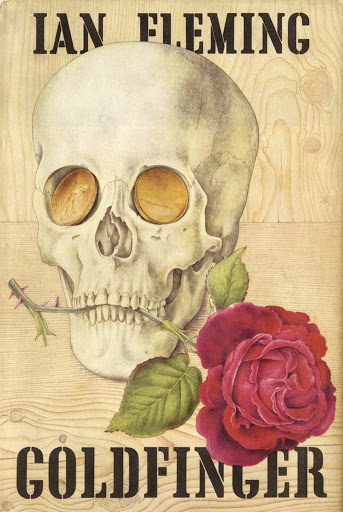

“Was there any person in the world who wasn’t somehow, perhaps only statistically, involved in killing his neighbour?”
Goldfinger, the seventh book in Ian Fleming’s James Bond series, pits the globetrotting protagonist against an extremely capable and merciless foe. The three-part novel contains high-stakes mental sparring, a trio of minor Bond girls, and an iconic villain and his sidekick. In essence, though, the three encounters between the two ultra-competitive alpha males amount to an extended manhood-measuring contest. The book isn’t as exciting as many that came before it in the series, but keeping the villain in the spotlight for so long allows for a more fleshed out, meaningful relationship between the hero and his adversary.
Auric Goldfinger is a comic book level criminal. He is driven by avarice, cheats at everything, and literally worships gold.1 His sidekick, Oddjob, is nearly his boss’s equal in malice, though he exhibits a good deal more physical competence. He is described as a black belt karateka, his hands and feet hardened into “layers of corn,” their wielder capable of killing with a blow to one of seven different spots on the body. Like most Bond villains, the duo are physically monstrous, with Bond describing Oddjob as a “chunky, flat-faced Japanese” and repeatedly calling him an ape (though maybe that’s just Fleming’s racism2). Goldfinger purposefully sunburns himself to draw attention away from his ugliness and his short stature.
Bond always mistrusted short men. They grew up from childhood with an inferiority complex. All their lives they would strive to be big—bigger than the others who had teased them as a child. Napoleon had been short, and Hitler. It was the short men that caused all the trouble in the world.
The book is broken into three sections that reflect a quote from Goldfinger: “Once is happenstance, twice is coincidence, the third time it’s enemy action.” In ‘Happenstance’ Bond bumps into Du Pont, a fellow who had witnessed his cardsharp exploits in Casino Royale. Du Pont recalls Bond’s capabilities and asks for Bond’s help in figuring out a wily opponent of his that he believes is cheating him at canasta. He meets Goldfinger, uncovers his little spy setup, and blackmails the cheater out of his dishonest earnings. Ever passionate for a good card game, Fleming inevitably treats the reader to a detailed description of the game between Goldfinger and Du Pont. It is not as bad as, say, the opening section of Moonraker, because for a large portion of this section Bond is sneaking around and finding Goldfinger’s secretary spying on Du Pont’s cards through the ceiling, where she secretly feeds updates to Goldfinger through his “hearing aid.”
Before heading back to England, Bond has a brief affair with Jill Masterson, Goldfinger’s secretary. In an uncharacteristic bit of self-analysis, Bond questions whether it was right to have relations with her.
It hadn’t been love, but a quotation had come into Bond’s mind as his cab moved out of Pennsylvania station: ‘Some love is fire, some love is rust. But the finest, cleanest love is lust.’ Neither had had regrets. Had they committed a sin? If so, which one? A sin against chastity? Bond smiled to himself. There was a quotation for that too, and from a saint—Saint Augustine: ‘Oh Lord, give me Chastity. But don’t give it yet!’
Fleming doesn’t stop after his loving description of canasta. The next “chance” encounter between Goldfinger and Bond is a high-stakes game of golf, another activity that Fleming is clearly enamored with and spends a goodly amount of time deliberating on. Coincidentally, when Bond reports back to M, he is told that he will be looking into Goldfinger, whom MI6 believes is smuggling gold out of England. Oh, and he is also uber-rich and financing SMERSH. So Bond contrives to bump into Goldfinger again and play a round of golf with him. Fortunately, I actually know most of the terminology and so Fleming’s jargon-packed description of the game was comprehensible. His understanding of the primal competitiveness between the two men is spot on as well. They bet the ten grand that Bond had blackmailed out of him during the canasta episode, then they both cheat. Bond wins and, impressed by his tenacity, Goldfinger invites him to his estate.
Bond continues sniffing around, figures out how Goldfinger’s smuggling operation works, yada yada yada, then ends up strapped spread eagle to a table with a circular saw slowly buzzings its way toward his man bits. Oh, and Bond had run into Tilly Masterson, Jill’s sister, who was trying to assassinate Goldfinger because he had painted Jill in gold and she had died from clogged pores. She gets captured too. Anyway, Goldfinger relents, and instead of killing Bond, forces him to work for him as payment for his life. He has a large operation planned in which Bond may prove useful: he intends to steal all of the gold from the United States Bullion Depository at Fort Knox.
Goldfinger hosts a meeting with the leaders of a handful of gangs, with Bond and Tilly Masterson working as his secretaries. The gang leaders are mostly forgettable, with the exception of Miss Pussy Galore, a lesbian who Bond turns straight by the book’s closing pages.3 Bond foils Goldfinger’s plan with the help of his old buddy Felix Leiter, and gets to knock off both Oddjob and Goldfinger.
There were only two things that I enjoyed more about Goldfinger than any of the other Bond novels. First is Bond’s sense of humor. Even in the face of death, he is constantly taking jabs at Oddjob (some of them are actually funny and not racist) and toying with Goldfinger. Second are the pages devoted to Goldfinger. I don’t find him the most compelling villain,4 but at least he is a character we get a chance to know.
But too often the characters do things that don’t feel in-character just to fit the outrageous plot. For instance, the ruthless Goldfinger allows Bond to live with the flimsiest of reasoning. Bond has been a constant annoyance to him and is laying on a table about to be buzzed in half; he has nothing to offer Goldfinger. But then Goldfinger inexplicably allows him to live so that he can pose as Goldfinger’s secretary. What?
Fleming’s writing technique—plugging away, not editing or revising anything until he’s finished—resulted in a clunker with Goldfinger. It’s definitely readable, but there are too many plot holes and loose ends (e.g. if Goldfinger worked for SMERSH, how had he not heard of James Bond?). These books are never worth taking seriously. They’re pulpy and entertaining and that’s what makes them fun. But Goldfinger fumbles too often to even meet that standard.
1. It is mentioned, but not lingered upon, that Goldfinger has women painted with gold, so that he can physically “possess” the gold.
2. Another for good measure: Bond desires to “put Oddjob and any other Korean firmly in his place, which, in Bond’s estimation, was rather lower than apes in the mammalian hierarchy.” Yikes. Oddjob also eats cats.
3. “They told me you only liked women.” “I never met a man before.” Such depth.
4. Both Goldfinger and Oddjob are depicted as purely evil, which makes for iconic characters (which they did become after the book was adapted into a film) but not compelling ones.